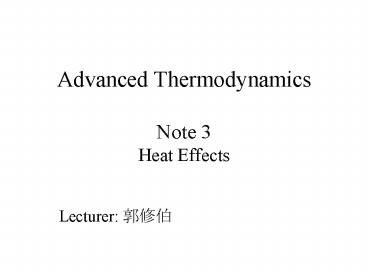Advanced Thermodynamics Note 3 Heat Effects - PowerPoint PPT Presentation
1 / 21
Title:
Advanced Thermodynamics Note 3 Heat Effects
Description:
... 3. Heat Effects. Lecturer: ???. Heat. The manufacture of ethylene glycol: ... The reactants, ethylene and air are heated to this temperature before they enter ... – PowerPoint PPT presentation
Number of Views:589
Avg rating:3.0/5.0
Title: Advanced Thermodynamics Note 3 Heat Effects
1
Advanced ThermodynamicsNote 3Heat Effects
- Lecturer ???
2
Heat
- The manufacture of ethylene glycol
- The catalytic oxidation reaction is most
effective when carried out at temperatures near
250C. - The reactants, ethylene and air are heated to
this temperature before they enter the reactor. - Heat is removed from the reactor to maintain the
reaction temperature at 250 C and to minimize
the production of CO2. - Heat effects are important.
3
Sensible heat effects
- Heat transfer to a system in which there are no
phase transition, no chemical reactions, and no
changes in composition cause the temperature of
the system to change. - Relation
- Quantity of heat transferred
- The resulting temperature change
- Two intensive properties establishes its state U
U (T,V)
4
constant-volume
mechanically reversible constant-volume process
.OR.
5
constant-pressure
mechanically reversible constant-pressure process
6
- Since or ,
we need C f (T). - From empirical equation
- For gases, it is the ideal-gas heat capacity,
rather than the actual heat capacity, that is
used in the evaluation of such thermodynamic
properties as the enthalpy. - Calculate values for a ideal-gas state wherein
ideal-gas heat capacities are used - Correction to real-gas value
- Ideal-gas heat capacities
- The two ideal-gas heat capacities
- The molar heat capacity of the mixture in the
ideal-gas state
7
- With
The function name is ICPH
Mean heat capacity subscript H denotes a mean
value specific to enthalpy calculations.
The function name is MCPH
It can be used to evaluate
8
Calculate the heat required to raise the
temperature of 1 mol of methane from 260 to 600C
in a steady-flow process at a pressure
sufficiently low that methane may be considered
an ideal gas.
9
What is the final temperature when heat in the
amount of 0.4 x 106 Btu is added to 25 (lb mol)
of ammonia initially at 500 F in a steady-flow
process at 1 (atm)?
Start with a value T ? T0, T converges no the
final value T 1250K
10
Latent heats of pure substances
- A pure substance is liquefied from the solid
state of vaporized from the liquid at constant
pressure, no change in temperature - The latent heat of fusion
- the latent heat of vaporization
- the coexistance of two phases
- According to the phase rule, its intensive state
is determined by just one intensive property.
Vapor pressure
Latent heat
11
- Rough estimates of latent heats of vaporization
for pure liquids at their normal points
(Troutons rule) - Riedel (1954)
- Accurate! Error rarely exceed 5
- Water
- latent heat of vaporization of a pure liquid at
any temperature, (Watson, 1943)
Absolute temperature of the normal boiling point
Critical temperature (bar)
Reduced temperature at Tn
12
Given that the latent heat of vaporization of
water at 100C is 2257 J/g, estimate the latent
heat at 300 C.
13
Standard heat of reaction
- A standard state is a particular state of species
at temperature T and at specified conditions of
pressure, composition, and physical condition as
e.g., gas, liquid, or solid. - Gases the pure substance in the ideal-gas state
at 1 bar. - Liquids and solids the real pure liquid or solid
at 1 bar. - All conditions for a standard state are fixed
except temperature. Standard-state properties are
therefore functions of temperature only. - Heat of reaction
14
Standard heat of formation
- A formation reaction is defined as a reaction
which forms a single compound from its
constituent elements, e.g., - The heat of formation is based on 1 mol of the
compound formed. - The standard heat of formation 298.15 K
- The standard heat at 25C for the reaction
15
Standard heat of combustion
- A combustion reaction is defined as a reaction
between an element or compound and oxygen to form
specific combustion products. - Many standard heats of formation com from
standard heats of combustion, measured
calorimetrically. - Data are based on 1 mol of the substance burned.
16
Temperature dependence of ?H
- A general chemical reaction
- standard heat of reaction
- if the standard-state enthalpies of all elements
are arbitrary set equal to zero as the basis of
calculation - For standard reactions, products and reactants
are always at the standard-state pressure of 1
bar
17
(No Transcript)
18
Calculate the standard heat of the
methanol-synthesis reaction at 800 C.
19
What is the maximum temperature that can be
reached by the combustion of methane with 20
excess air? Both the methane and the air enter
the burner at 25C.
Maximum attainable temperature ? adiabatic, Q 0
? ?H 0
Products at 1 bar and T K 1 mol CO2 2 mol H2O 0.4
mol O2 9.03 mol N2
Start with T gt 298.15 K and converge on a final
value of T 2066K
?H 0
Reactants at 1 bar and 25C 1 mol CH4 2.4 mol
O2 9.03 mol N2
20
Catalytic reforming of CH4
The only other reaction occurs
Calculate the heat requirement.
Not independent, choose (1) and (3) reactions
Products at 1 bar and 1300 K 0.87 mol CO 3.13 mol
H2 0.13 mol CO2 0.87 mol H2O
?H 0
Reactants at 1 bar and 600K 1 mol CH4 2 mol H2O
21
0.87 mol CH4 by (1) and 0.13 mol CH4 by (3)
Steady flow, no shaft work, kinetic and potential
energy changes are negligible































